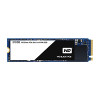Western Digital Black PCIe SSD M.2 Desktop Installation Guide - Page 9
Solid State Device SSD, M.2 edge connector with the M Key ID. Although
 |
View all Western Digital Black PCIe SSD manuals
Add to My Manuals
Save this manual to your list of manuals |
Page 9 highlights
Glossary Express has been designed from the ground up, capitalizing on the low latency and parallelism of PCI Express SSDs, and mirroring the parallelism of contemporary CPUs, platforms and applications. By allowing parallelism levels offered by SSDs to be fully utilized by a host's hardware and software, NVM Express brings various performance improvements. Therefore, to experience the best performance, NVMe is best implemented with a direct PCI Express connection, foregoing any backwards compatibility with SATA. NVM Express should not be confused with SATA Express, which is a host bus specification (or physical interface) that supports both SATA and PCIe storage devices, and suffers from limitations that are not bound to NVMe. NVM Express is supported natively from Windows 8.1, Windows Server 2012 R2, and Linux Kernel 3.3. NVM Express SSDs exist both in the form of standard-sized PCI Express expansion cards (Add-in card or AIC) and as 2.5-inch drives that provide a four-lane PCI Express interface through the U.2 connector (formerly known as SFF-8639) or the M. 2-M connector (this is a specific M.2 edge connector with the "M Key ID"). Although NVMe is supported as a logical device interface for SATA Express storage devices, it would be limited in performance by the SATA Express standard, which among other limitations, provides only a two-lane PCI Express interface. Solid State Device (SSD) Known either as Solid State Drive or Solid State Device, an SSD is a device that stores data using microchips (usually NAND Flash) instead of using magnetic disks that spin, like the technology used in hard disk drives (HDDs). WD Black PCIe SSD 6 M.2 Desktop Installation Guide











